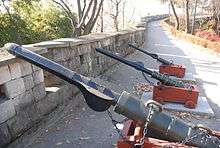Chongtong

| Chongtong | |
| Hangul | 총통 |
|---|---|
| Hanja | 銃筒 |
| Revised Romanization | chongtong |
| McCune–Reischauer | ch'ongtong |
The Chongtong was the name of most of the Korean gunnery used during the Joseon Dynasty. There were many different types, various improvements over the years, often including renaming. The well-known "Cheonja", "Jija", "Hyeonja", and "Hwangja" were named after the first four characters of the Thousand Character Classic in decreasing size, thus making them equivalent to Cannons A, B, C, and D.[1]
History
Gunpowder first came to Korea in the mid 14th century, but it was not until the 1370s when Korea began its own production. Choe Museon had to reinvent gunpowder weapons in Korea, due to the Chinese refusing to share the technology with the Koreans.
During the reign of Taejong of Joseon, improvements were made, and still more were made by Sejong the Great in the 1440s.
During the mid 16th century the classic Cheonja, Jija, Hyeonja and Hwangja chongtong appeared. Earlier in the century, the bullanggi, a breech-loading swivel gun was introduced from Portugal via China.
In 1596, more improvements were made, and by this time the Seungja class of hand-cannons were phased out in favor of Japanese-style muskets and arquebuses. The Koreans called these jochong (조총/鳥銃).
During the 1650s, Hendrick Hamel and others were shipwrecked on Jejudo, introducing a Dutch cannon the Koreans called the hong'ipo, and used it alongside the native Korean cannons.
They were finally discontinued in the late 19th century when Joseon abolished the old-style army in favor of an army based on contemporary Western militaries.
Cannons
Cheonja-Chongtong
The 'Sky' or 'Heaven' (Hangul: 천자총통; Hanja: 天字銃筒) type cannon was the largest of the chongtong. Its length was about 1.3 m and the bore was about 13 cm. One of the projectiles it fired was a 30 kg 'daejanggunjeon', a large rocket-shaped arrow with an iron head and fins. The cheonja could fire one of these up to about 1.4 km.
Jija-Chongtong
The 'Earth' (Hangul: 지자총통; Hanja: 地字銃筒) cannon was a little smaller, about 1 m long with a bore of about 10 cm. It could fire a 16.5 kg 'janggunjeon' (similar to the daejanggunjeon, only smaller) about 1 km.
Hyeonja-Chongtong
The 'Black' (Hangul: 현자총통; Hanja: 玄字銃筒) type was about 0.8 m long with a bore of about 8 cm and could fire a 'chadajeon' (similar to the janggunjeon) that weighed about 3.5 kg up to about 1 to 2 km.
Hwangja-Chongtong
The 'Yellow' (Hangul: 황자총통; Hanja: 黃字銃筒) was the smallest of the cannons. It resembled the European hand-cannon. Its bore was about 5 cm and shot a large arrow (similar to the chadaejeon) that weighed about 1.5 kg or four ordinary arrows at once which had a range of about 730 m.
Handheld guns
Se-Chongtong
The 'Thin' (Hangul: 세총통; Hanja: 細銃筒) had a range of about 150 m.
Seungja-Chongtong
The 'Victor' (Hangul: 승자총통; Hanja: 勝者銃筒) fired various small projectiles like pellets, bullets, arrows,arrows with war head, etc.
Other firearms used by Koreans in the 16th century
- Samchongtong
- Chongtongwan-gu
- Janggunhwatong
- Ilchongtong
- Yichongtong
- Paljeonchongtong
- Sajeonchongtong
- Bullanggi (breech-loading swivel gun introduced from Europe via China)
- Wan-gu mortars
- Baekjachong
See also
References
- ↑ Turnbull, Stephen, "Fighting Ships of the Far East, Volume 2: Japan and Korea", Jan 25, 2003, p. 21.